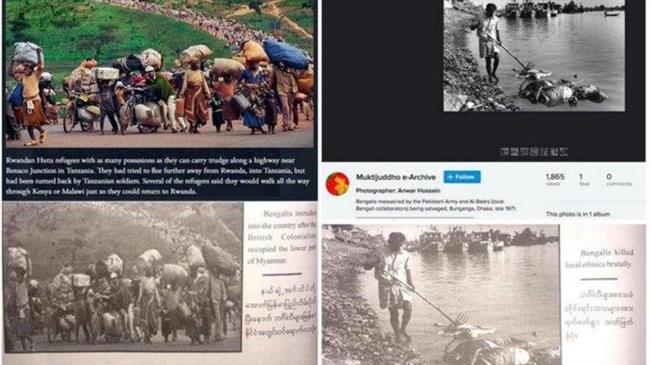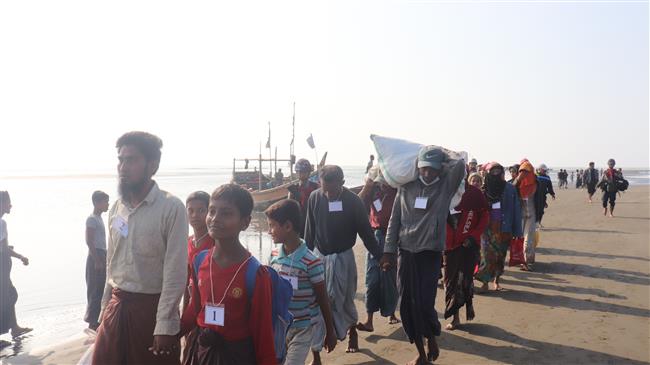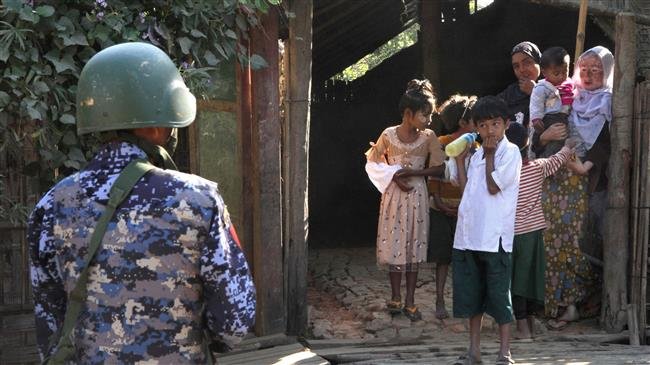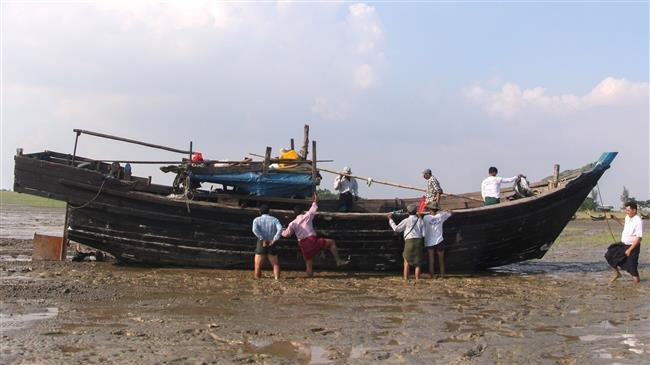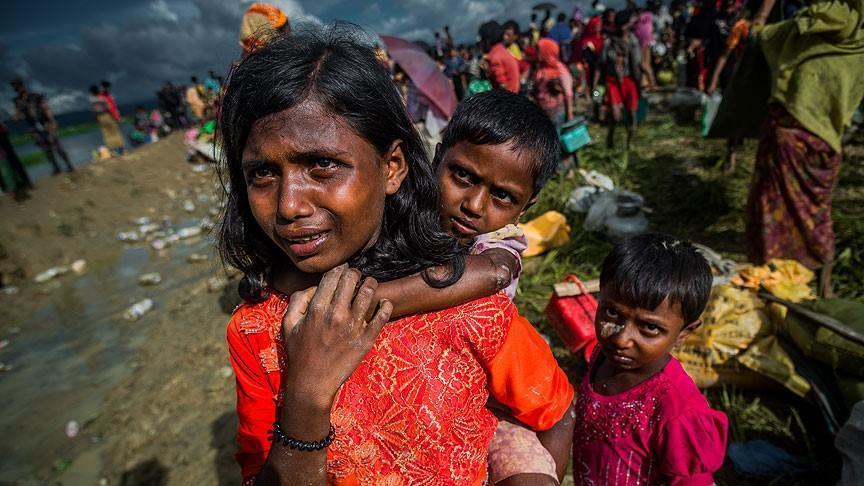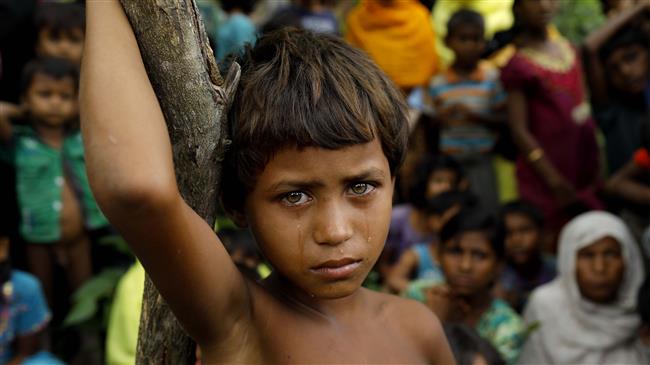The grainy black-and-white photo, printed in a new book on the Rohingya crisis authored by Myanmar's army, shows a man standing over two bodies, wielding a farming tool. "Bengalis killed local ethnics brutally," reads the caption.
Publish dateSaturday 1 September 2018 - 17:09
Story Code : 169785
AVA- The photo appears in a section of the book covering ethnic riots in Myanmar in the 1940s. The text says the image shows Buddhists murdered by Rohingya - members of a Muslim minority the book refers to as "Bengalis" to imply they are illegal immigrants.
But a Reuters examination of the photograph shows it was actually taken during Bangladesh's 1971 independence war, when hundreds of thousands of Bangladeshis were killed by Pakistani troops.
It is one of three images that appear in the book, published in July by the army's department of public relations and psychological warfare that have been misrepresented as archival pictures from the western state of Rakhine.
In fact, Reuters found that two of the photos originally were taken in Bangladesh and Tanzania. A third was falsely labelled as depicting Rohingya entering Myanmar from Bangladesh, when in reality it showed migrants leaving the country.
Government spokesman Zaw Htay and a military spokesman could not be reached for comment on the authenticity of the images. U Myo Myint Maung, permanent secretary at the Ministry of Information, declined to comment, saying he had not read the book.
The 117-page "Myanmar Politics and the Tatmadaw: Part I" relates the army's narrative of August last year, when some 700,000 Rohingya fled Rakhine to Bangladesh, according to United Nations agencies, triggering reports of mass killings, rape, and arson. Tatmadaw is the official name of Myanmar's military.
Much of the content is sourced to the military's "True News" information unit, which since the start of the crisis has distributed news giving the army's perspective, mostly via Facebook.
The book is on sale at bookstores across the commercial capital of Yangon. A member of staff at Innwa, one of the biggest bookshops in the city, said the 50 copies the store ordered had sold out, but there was no plan to order more. "Not many people came looking for it," said the bookseller, who declined to be named.
On Monday, Facebook banned the army chief and other military officials accused of using the platform to "inflame ethnic and religious tensions". The same day, UN investigators accused Senior General Min Aung Hlaing of overseeing a campaign with "genocidal intent" and recommended he and other senior officials be prosecuted for crimes against humanity.
In its new book, the military denies the allegations of abuses, blaming the violence on "Bengali terrorists" it says were intent on carving out a Rohingya state named "Arkistan."
The book also seeks to trace the history of the Rohingya - who regard themselves as native to western Myanmar - casting them as interlopers from Bangladesh.
In the introduction to the book the writer, listed as Lieutenant Colonel Kyaw Kyaw Oo, says the text was compiled using "documentary photos" with the aim of "revealing the history of Bengalis."
"It can be found that whenever a political change or an ethnic armed conflict occurred in Myanmar those Bengalis take it as an opportunity," the book reads, arguing that Muslims took advantage of the uncertainty of Myanmar's nascent democratic transition to ignite "religious clashes."
But a Reuters examination of the photograph shows it was actually taken during Bangladesh's 1971 independence war, when hundreds of thousands of Bangladeshis were killed by Pakistani troops.
It is one of three images that appear in the book, published in July by the army's department of public relations and psychological warfare that have been misrepresented as archival pictures from the western state of Rakhine.
In fact, Reuters found that two of the photos originally were taken in Bangladesh and Tanzania. A third was falsely labelled as depicting Rohingya entering Myanmar from Bangladesh, when in reality it showed migrants leaving the country.
Government spokesman Zaw Htay and a military spokesman could not be reached for comment on the authenticity of the images. U Myo Myint Maung, permanent secretary at the Ministry of Information, declined to comment, saying he had not read the book.
The 117-page "Myanmar Politics and the Tatmadaw: Part I" relates the army's narrative of August last year, when some 700,000 Rohingya fled Rakhine to Bangladesh, according to United Nations agencies, triggering reports of mass killings, rape, and arson. Tatmadaw is the official name of Myanmar's military.
Much of the content is sourced to the military's "True News" information unit, which since the start of the crisis has distributed news giving the army's perspective, mostly via Facebook.
The book is on sale at bookstores across the commercial capital of Yangon. A member of staff at Innwa, one of the biggest bookshops in the city, said the 50 copies the store ordered had sold out, but there was no plan to order more. "Not many people came looking for it," said the bookseller, who declined to be named.
On Monday, Facebook banned the army chief and other military officials accused of using the platform to "inflame ethnic and religious tensions". The same day, UN investigators accused Senior General Min Aung Hlaing of overseeing a campaign with "genocidal intent" and recommended he and other senior officials be prosecuted for crimes against humanity.
In its new book, the military denies the allegations of abuses, blaming the violence on "Bengali terrorists" it says were intent on carving out a Rohingya state named "Arkistan."
The book also seeks to trace the history of the Rohingya - who regard themselves as native to western Myanmar - casting them as interlopers from Bangladesh.
In the introduction to the book the writer, listed as Lieutenant Colonel Kyaw Kyaw Oo, says the text was compiled using "documentary photos" with the aim of "revealing the history of Bengalis."
"It can be found that whenever a political change or an ethnic armed conflict occurred in Myanmar those Bengalis take it as an opportunity," the book reads, arguing that Muslims took advantage of the uncertainty of Myanmar's nascent democratic transition to ignite "religious clashes."
Source : خبرگزاری Afghn Voice Agency(AVA)
avapress.net/vdcfc1dytw6dvea.r7iw.html
Tags
Top hits
